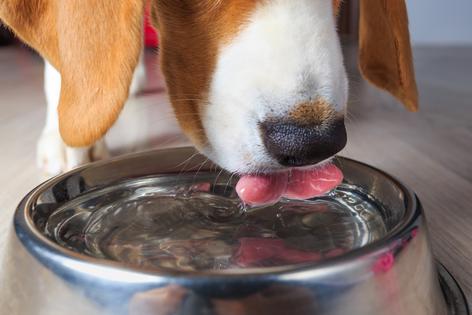My Pet World: New product may be the answer for sloppy drinking dogs
Dear Cathy,
We had the same problem with our Golden Doodles as Beverly from Juneau, Wisconsin, did with her two-year-old yellow lab Charlie. They are slovenly drinkers. We discovered a water bowl that keeps all water contained — it's called the Slopper Stopper.
It takes dogs a few drinks to figure it out, but they get used to it. They have a variety of bowl sizes based on the size of your dogs. It is amazing. There is no more water on the floor anymore. This bowl is a game-changer.
— Elizabeth, Virginia Beach, Virginia
Dear Elizabeth,
I rarely put a product question or tip as the first letter in this column. But, when I checked out the “Slopper Stopper Dripless Water Bowl,” as you suggested, I felt many readers would benefit from learning about this product.
The Slopper Stopper Dripless Water Bowl (say that three times real fast) is a stainless-steel bowl with an inverted lid that allows dogs to drink from a smaller aperture, which seems to keep them from scooping up big mouthfuls of water. It also prevents them from submerging their snout and ears, which also contribute to the watery mess around the water bowl.
It looks like it would only take a few minutes for dogs to learn how to use it. I see it's gotten great reviews too. The key is making sure you order the right size for your dog or dogs. If it works as well as the videos show – and you claim from your own experience – this is indeed a game changer for people with sloppy drinking dogs.
If you have a messy drinker, check out the product at: https://www.slopperstopper.com/
Dear Cathy,
I have a four-year-old rescue cat that we got at nine months old. For three years, he had no problem using the litter box. A little over a month ago, he started pooping in the dining room. He still uses the litter box to pee in but won't when he poops. The litter has been the same brand since we got him. We have had cats for over 40 years, and this is the first we have ever experienced this.
— Joe, Seaford, New York
Dear Joe,
Whenever sudden behavior changes occur, I recommend visiting the vet to first rule out any health problems. So, please do that first. There is a chance that your cat may be a little constipated, and if he is, it can be uncomfortable for him to poop in the litter box. Your vet can talk to you about that as well, but here are my recommendations.
First, add more water to his diet by feeding him wet food or buying a kitty water fountain. Cats love drinking water from a faucet, so your cat should easily adjust to the fountain.
Second, add an over-the-counter digestive supplement to his diet, which could be a high-fiber treat or a supplement that aids digestion. There are lots of products and even pet foods that are designed to improve digestion.
Next, try an over-the-counter cat litter attractant that you can sprinkle in the litter box. These products are scent lures designed to draw your cats back to the box.
And, finally, add a second litter box to your home. Make sure you place it in a low-traffic location where your cat can’t get startled by other animals or humans. If your cat was startled while pooping, he may associate the action with the fear he felt at the time.
Let me know how it goes.
Dear Cathy,
I am writing about the dog who suddenly wouldn't use the steps to get onto the bed. We had a similar problem with our eight-year-old Bichon Frise. My husband had the brilliant thought that our dog had lost traction while trying to use the stair and got freaked out.
So, we put a small rug under the stair that extended out a few feet, which solved the problem. It could also be that the dog's eyesight has diminished, and just making sure the area is well-lit when the dog wants to get on the bed might help.
— Trish, Tucson, Arizona
Dear Trish,
As we age, stairs are more challenging for humans and dogs alike. Making accommodations, like picking up a dog and placing him on and off the bed, keeping the space illuminated so they can see the stair or stairs, providing a carpet under a stair for traction (good thinking on your husband’s part), and switching a stair out for a ramp — are all easy things to try when this happens to our canine friends.
Thanks for sharing your tips.
_____
_____
========
(Cathy M. Rosenthal is a longtime animal advocate, author, columnist and pet expert who has more than 25 years in the animal welfare field. Send your pet questions, stories and tips to cathy@petpundit.com. Please include your name, city, and state. You can follow her @cathymrosenthal.)
©2023 Tribune Content Agency, LLC.
(c) 2023 DISTRIBUTED BY TRIBUNE MEDIA SERVICES, INC.












Comments